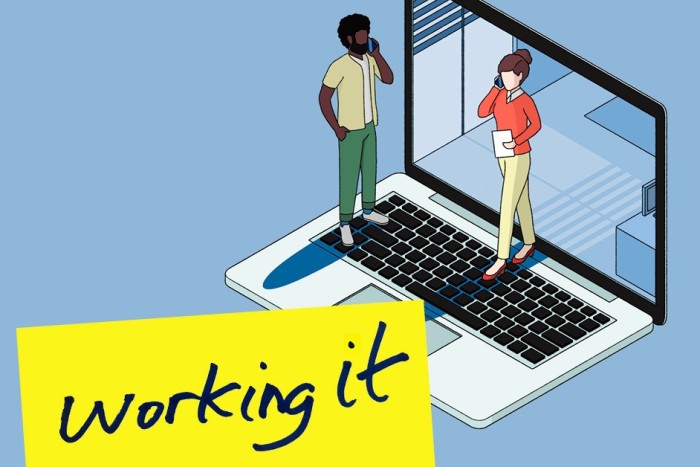The new workplace: what young starters need to know

Roula Khalaf, Editor of the FT, selects her favourite stories in this weekly newsletter.
Leaving education and joining the world of work is a “jolt” for graduates. “They don’t know what employment is about,” says Chris Hirst, chief executive of the advertising agency Havas Creative. The challenge, he says — both for employers and the new employees themselves — is how quickly graduates can become “really useful” without the same level of “nurturing and structured learning” they received at university.
Graduates whose university education was disrupted by the pandemic, and whose only work experience might have been a remote “placement”, are about to enter workplaces that are grappling with hybrid work, as well as squeezed training budgets.
According to a report by the Chartered Institute of Personnel and Development (CIPD), a human resources association, about a third of UK organisations reported reducing their learning and development budgets, their headcount, and their use of external consultants during the pandemic.
That, plus the requirement for social distancing, explains the switch to tech platforms. Prior to 2020, just 36 per cent of organisations used webinars or virtual classrooms, according to the CIPD, rising to 51 per cent last year. For graduates, training is more blended than ever before, says Alastair Woods, global co-leader for people analytics at accountancy firm PwC. “If you are training to be an accountant or analyst, a greater proportion is online.”
Simon Hallett, resourcing director at Deloitte, says the pandemic forced the professional services firm to re-evaluate its training and to consider “whether we needed to return to in-person after pivoting to 100 per cent online”. The firm has adopted a 50:50 blend of online and in-person learning.
The benefits of online learning for graduates are that they can learn at their own pace and replay lessons. Now, employers are exploring how to bring their latest recruits up to speed with new working patterns and organisational culture, as well as developing their soft skills, such as communication, as well as the technical skills actually required to do their jobs.
“Companies that don’t update their training models in response [to hybrid working] are going to become less competitive,” says Jeff Maggioncalda, chief executive of Coursera, a course provider.
In many ways, hybrid graduate education will have served as good preparation for the new workplace, even if companies are still adjusting to the new realities. But some patterns are becoming clear.
One approach that looks likely to persist is buddying systems, which many organisations introduced or reinforced during the pandemic. The consultancy Oliver Wyman, for example, is matching new graduates with two or three senior people for informal check-ins, rather than with the one or two it assigned before the pandemic.
At Standard Chartered, the bank’s approach is in line with its hybrid working patterns, dubbed internally “Future Workplace, Now”. It includes a mix of hands-on and face-to-face learning, and online training. All graduates have access to a global learning platform called diSCover, which provides training in areas such as sustainable finance, digital banking and cyber security. To help with career growth and personal development, the lender is also encouraging feedback via a digital tool — last month, it held a “Feedback5” challenge that encouraged all employees to provide weekly feedback for five weeks.

Harriet Skipworth, director of learning and development at Oliver Wyman, says “the pandemic has kick-started new initiatives”, such as signing up to Degreed, a platform that facilitates just-in-time e-learning. Intensive use of videoconferencing has also changed the way the consultancy thinks about training. “The benefits of doing quick breakouts, the polling, putting something into Zoom chat, is in the back of our minds as we design new programmes now,” Skipworth says.
Technology can even help teach soft skills and reinforce learning. Dominic Putt, a learning and development expert at PwC, says that its online platform draws on cognitive science and machine learning to push tailored questions to users.
“If we want people to change behaviours, they need to remember what they are supposed to do differently,” he says. Regular refreshers help learners to remember information for longer, and build new habits.
Used well, technology can also complement in-person training by helping graduates prepare in advance. Putt gives the example of learners watching videos on theory and techniques before coming together with their peers, and moving on to sessions “with actors playing different characters for people to practice how they might respond”.
At Deloitte, junior employees develop public speaking and professional writing skills through off-site programmes and virtual workshops. Using the company’s Toastmasters network, they can practice public speaking and presentation techniques in a virtual environment.
Working It podcast

Whether you’re the boss, the deputy or on your way up, we’re shaking up the way the world works. This is the podcast about doing work differently.
Join host Isabel Berwick every Wednesday for expert analysis and water cooler chat about ahead-of-the-curve workplace trends, the big ideas shaping work today — and the old habits we need to leave behind.
The company is also creating a new website to support training and teach staff about its culture. A report by Leeds University Business School looking at remote interns’ experiences recommends that employers promote aspects of organisational culture online, such as “etiquette and norms” on communication and formality, and “examples of the company’s values in practice”.
Yet there is only so much that can be taught online, argue advocates for a return to the office. Goldman Sachs’s chief executive, David Solomon, has been notably vociferous on the need for young recruits to learn by osmosis — more easily done when people can overhear conversations and observe experienced peers in meetings or negotiations. “Without being around people it’s very difficult to learn those vocational skills,” says Hirst, who advocates a blend of remote and office working.
The risk of too much working from home, says Helen Hughes, associate professor at Leeds University Business School and co-author of the report on remote internships, is that young recruits do not understand the workplace norms.
She says some of the interns she surveyed struggled to manage their workload because they found it difficult “to understand that peaks and troughs were normal when they couldn’t benchmark” their experience against their peers in the office.
The research also found that while young employees were quick to pick up digital skills, this masked “deep-rooted insecurities about working life more generally . . . [making] the challenges such that employees are facing more difficult for organisations to recognise and address”, Hughes says.
Some graduates who started at Oliver Wyman during the pandemic will repeat parts of their training. “The apprenticeship model is so much harder to work [remotely],” says Skipworth. However, Charlie Ball, senior consultant in labour market intelligence at Jisc, a UK-based non-profit technology provider, says that learning in the office is not an argument for forcing younger workers back full-time. “By and large, younger workers like hybrid working,” he says.
Employers’ insistence that osmotic learning can be facilitated only by a return to the office can smack of “laziness” on the part of employers, says Hirst. “The most junior person in a meeting very commonly will just sit in a meeting. The advice, spoken or unspoken, is just to watch and learn. It requires very little effort or imagination to give that person a clear role without pretending they’re going to be the chief strategy officer. Give them a slide to present, ask their opinion — the return on that can be beneficial.”
Comments